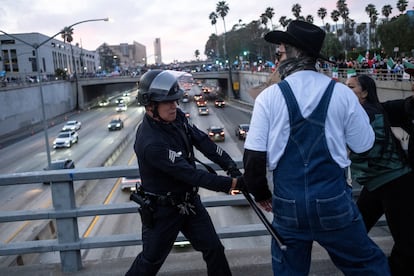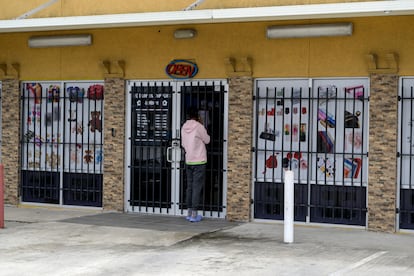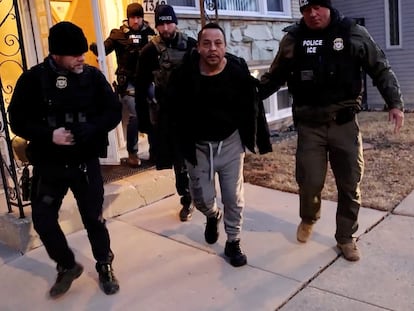Trump’s crackdown on migrants heats up the streets
Protests organized organically on social media are emerging in various parts of Texas, New York and California to reject the Republican administration’s policies

A day without immigrants. That is what tens of thousands of Latinos asked the rest of the United States to imagine on Monday, when a national protest was called to stay home from work and school. The demonstration was organized organically on social media, but was also palpable in the streets of cities with a large Hispanic community. These are signs of the rejection of the policies of Donald Trump, who has launched a hunt for undocumented immigrants since his return to the White House.
“In the schools, NO ICE!” shouted dozens of migrants on Monday afternoon in New York to reject the presence of immigration police in schools. This has been one of the lines crossed by the policies of the Republican Administration, which has empowered federal agents to carry out operations practically everywhere. The protesters advanced on Monday afternoon along 42nd Street towards Times Square, in Manhattan, waving Mexican flags and shouting slogans against Trump.
At the other end of the country, Los Angeles experienced two days of protests, in a sign that the mood against Trumpist measures is heating up. Hundreds of people gathered on Monday afternoon near City Hall with flags of Mexico, Guatemala and El Salvador, among other nations, including the United States. Below the group of protesters, drivers passing by on Highway 101 honked their horns in support or shouted “Yes we can!”
“My parents fought for my future and now it’s my turn to fight for theirs,” said Laura V., a 37-year-old woman who has been in the United States since she was three. Her parents crossed into the country from Sásabe (Sonora) in the 1990s to work in a textile factory in the city center. “It’s important to go out and let Donald Trump know that we will not remain silent while he separates families,” said Laura, an employee of a business in the city of Burbank, who notified her boss on Friday that she would not go to work. “He understood very well because his family is also Hispanic,” said Laura, who asked not to use her last name for fear of reprisals.
It was the second protest in the same location in 48 hours. On Sunday, in a much larger demonstration because it was a day off, about 2,000 people marched up the ramps to the freeway and blocked traffic for several minutes. Dozens of police officers dressed in tactical and riot gear stood in line to prevent the flow of people from moving forward. The demonstration was mostly uneventful. There was some graffiti, including some that said “Fuck ICE” on public transit buses. At another protest in Oxnard, northwest of Los Angeles, an American flag was burned.
The protests have already sparked a reaction from the right. Georgia Congressman Mike Collins has promised to introduce a bill on Capitol Hill to make highway protests a federal crime. “First it was Hamas supporters, and now it’s illegals and their supporters,” the Republican lawmaker said. Other supporters of President Trump expressed disappointment with local police for not stopping protesters during the demonstration.

Sunday’s demonstration began at Placita Olvera, a downtown spot considered the origin of Los Angeles, as it was there that the first migrants from Mexico settled in the 18th century. The rally called on those without papers to abstain in order to avoid a possible arrest that could lead to deportation.
The protests have not only occurred in the large sanctuary cities, progressive enclaves where local authorities have shown skepticism about large-scale federal operations against undocumented immigrants. This weekend there were also protests in Texas, the great Republican stronghold.
“Immigrants pay more taxes than Trump,” “Stop mass deportations” and “No one is illegal on stolen land” were some of the messages launched at a nighttime protest on Saturday in McAllen, a Texas city on the border with Mexico.
“Seeing all these people tells me that there is a lot of heart in this Rio Grande Valley, we still have hope and faith that things will change,” said Gilberto Valdez, who called for the mobilization through TikTok and saw his expectations exceeded, in statements to local media.
A day without Mexicans
The idea of a day without immigrants in the United States was brought to the screen by actress Yareli Arizmendi and the musician and filmmaker Sergio Arau. The Mexican couple first made a short film in 1998. The video’s reception led to the provocative idea being turned into a feature film released in 2004. Two decades later, Latinos must continue to defend their worth in American society.
“Conditions are worse now than when we started doing this,” Arau said by phone. “It is very worrying. Migrants are the most vulnerable population there is. Undocumented people are the closest thing there is to modern-day slaves. They lend themselves to all kinds of abuse and injustice,” the filmmaker said.

The initiative urges this sector of the population to gain visibility through absence. The idea is taken up at the local level with some regularity, generally when a Republican governor approves legislation that is hostile to minorities. In recent years, similar action was observed in Alabama and last year, in Ron DeSantis’ Florida.
Arau and Arizmendi are working with several organizations to make A Day Without Mexicans a fixed date on the calendar. “If we organize ourselves, we can demand more and better treatment. One day is enough to make the weight of Latinos and Mexicans felt. That way they would see what we contribute to the country,” he says. The debate between different groups is underway. The tentative date is May 1.
Sign up for our weekly newsletter to get more English-language news coverage from EL PAÍS USA Edition
Tu suscripción se está usando en otro dispositivo
¿Quieres añadir otro usuario a tu suscripción?
Si continúas leyendo en este dispositivo, no se podrá leer en el otro.
FlechaTu suscripción se está usando en otro dispositivo y solo puedes acceder a EL PAÍS desde un dispositivo a la vez.
Si quieres compartir tu cuenta, cambia tu suscripción a la modalidad Premium, así podrás añadir otro usuario. Cada uno accederá con su propia cuenta de email, lo que os permitirá personalizar vuestra experiencia en EL PAÍS.
¿Tienes una suscripción de empresa? Accede aquí para contratar más cuentas.
En el caso de no saber quién está usando tu cuenta, te recomendamos cambiar tu contraseña aquí.
Si decides continuar compartiendo tu cuenta, este mensaje se mostrará en tu dispositivo y en el de la otra persona que está usando tu cuenta de forma indefinida, afectando a tu experiencia de lectura. Puedes consultar aquí los términos y condiciones de la suscripción digital.











































